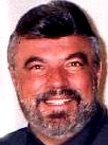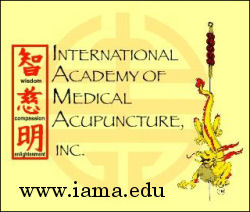Acupuncture & TCM Articles

Acupuncture Articles
by John A. Amaro L.Ac., Dipl.Ac.(NCCAOM), DC
 Dr. Amaro is an internationally known author, lecturer and practitioner beginning his practice of Acupuncture and Chiropractic in 1971. He has led 13 diplomatic Acupuncture study tours of The People's Republic of China escorting more than 500 doctors and practitioners. He has personally studied Acupuncture in nine separate Asian nations. Dr. Amaro is an internationally known author, lecturer and practitioner beginning his practice of Acupuncture and Chiropractic in 1971. He has led 13 diplomatic Acupuncture study tours of The People's Republic of China escorting more than 500 doctors and practitioners. He has personally studied Acupuncture in nine separate Asian nations.
He has received Certification in Acupuncture through the Columbia Institute of Chiropractic in 1973. This was one of the first Acupuncture postgraduate education programs for physicians in North America commencing in 1972.
He has been certified by the Waseda Acupuncture College in Tokyo, Japan in 1974 and graduated from the Chinese Medical Institute, Kowloon, China in 1976. He had previously taken postgraduate studies at the Tai Chung Medical School Taipei, China 1973.
“Now, what do I do” ?
John A. Amaro L.Ac., Dipl.Ac.(NCCAOM), DC
Some years ago after considerable hounding by the publisher of a national health magazine, I finally got around to sitting at the kitchen table one gloomy Sunday afternoon to write out a long-promised article on acupuncture. I pulled out a couple of graphics, a cover letter, and the article was mailed without fanfare on Monday morning. Little did I know this simple article would change the lives of numerous individuals for years to come?
Approximately three months after the article appeared, I received a letter from a medical physician in Connecticut asking, "Now what do I do"? His letter stated he had as a patient a 42-year-old male who suffered from nocturnal enuresis and had wet the bed to some degree, anywhere from a few tablespoons to a full saturation literally every night of his life without exception.
The patient had received every known treatment, medication, remedy, counseling, etc., since he was a child. Other than the fact this adult male suffered from nocturnal enuresis, there was absolutely nothing wrong viscerally or psychologically, as far as anyone could determine. The reason for the physician's question was, following the first attempt at a simplified acupuncture procedure I had explained in the article, and utilizing, of all things, pressure from a ball-point pen to what may be considered a highly questionable acu-point, the patient, from the first day of stimulation, never experienced another bed-wetting incident in the one year I followed up on the case following my communication with this doctor. Incidentally, the MD had no knowledge of acupuncture, philosophy, theory, or anything other than his new found awareness of an acupoint which according to the article was to have an effect on bed wetting.
The doctor's question of "Now what do I do"? was certainly a legitimate one, for what he was asking was: What do I do now; do I continue to treat him or leave the condition alone? The answer to this question depends, of course, on who is answering. To me, the answer is obvious. To quote an old quote, "If it's not broken, don't fix it.’
Everyone is familiar with the three monkeys carved 800 years ago into the side of a former horse stable in Japan which illustrates “Hear no evil, see no evil and speak no evil’. This carving is internationally known, however the small relief which sits next to it shows a cat, sleeping under flowers. The philosophy of this relief was “What do you say to a sleeping cat under flowers in bloom’? Of course the answer is nothing, let the cat sleep, leave it alone.
Far too often we, as practitioners, do not leave conditions alone once they have attained healing and symptomatic relief and can be found guilty of one of the worst clinical and professional mistakes a practitioner can make which is simply "over treating." Ask yourself how many times in the last year have I seen a patient who was asymptomatic after a short term of treatment and, because "the treatment plan wasn't finished," the patient had the "anything you say, Doc" attitude, or any number of other reasons -- to include unfortunately "greed" -- we went ahead and treated the patient only to see their symptoms return to full blown status??
If you're a student or a very young practitioner, and you haven't experienced this yet, be patient; it happens to all of us. However, the objective is to learn by our mistakes and the mistakes of others, and minimize this occurrence.
In my opinion, one of the cardinal rules of healing is to understand when the patient is to be released from active care. Had the medical doctor from Connecticut continued to treat the same acu-point which relieved the symptoms of the patient, the possibility and probability of the original symptoms returning is a significant factor. In the case of the patient with the 42 year nocturnal enuresis, the treatment consisted of one treatment with a ball point pen to a specific acupoint. That was all that was necessary. The patient would have agreed to having treatment every day for the rest of his life had that been suggested at considerable financial reward for the practitioner, however, the doctor received a much larger reward through the multitude of referrals and personal satisfaction by releasing him even though he only had one treatment.
Use common sense in scheduling your patients' continuing care. Acupuncture point stimulation can have an immediate energetic healing response which will alter the selection of future rationale for treatment. Proper evaluation of the patient is essential in determining on-going treatment. If you are not at that point in your clinical development to determine by examination what to do next, you are best advised to discontinue the use of any specific acu-point as soon as significant clinical response has been achieved.
I routinely schedule three to five new patients a day and have for a number of years. All of my patients come from either patient referral or colleague referral. Even though I've heard my philosophy criticized as being wrong for practice development, I nevertheless stand by it, and that is to release the patient from active care as quickly as possible. I find if I schedule patients to return for management treatment three or four times a year as opposed to trying to cram once a month or more down their throat, my referrals and follow-up treatments rise significantly. I schedule maintenance treatments whenever the universe changes and that is when the four seasons are observed. When spring turns to summer and for each of the seasons we will find the body likewise experiences similar changes. I also don't cut off my referral trees limbs by dragging the patients on at a particular time when they really don't understand why they are still coming to the office since they are no longer experiencing a problem.
I fully realize the response to that last comment is simply "patient education," and I agree. However, I have not found my philosophy to be anything but successful.
We've all heard the adage, "Find it, fix it, and leave it alone." Sage advice from the old-timers. The significance of that statement may well be the best advice you'll hear all year.
Incidentally, the point for bed-wetting the doctor used on his 42-year-old patient is in the exact center of the bilateral proximal pip and dip joint of the small finger on the palmar side.
Attempt to achieve stellar clinical and healing response in the least amount of time, with the least amount of treatment, with minimal financial outlay and your practice will be overflowing with grateful, happy, referring patients.
|
